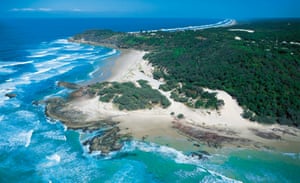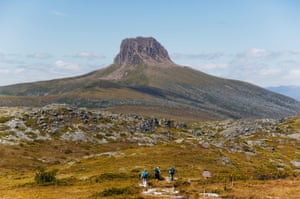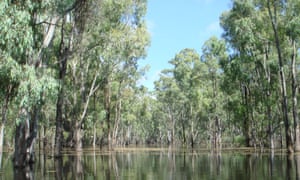Extract from The Guardian
The government has committed to protecting our national parks and
biodiversity, yet investment is lower and jobs have been slashed
National
parks are under siege in Australia. There are more than 500 parks in
Australia, covering 28 million hectares or almost 4% of the country, but
after decades of steadily adding to our national estate and making
progress towards honouring our international commitments to protect
biodiverse regions, Australia’s commitment has waned.
Funding has been slashed at both the state and federal levels and the creation of new national parks has stalled.
Several state governments have actively undercut the protection that national parks are entitled to by allowing uses that undermine the parks’ primary purpose to protect endangered ecosystems.
Together this has put in doubt our ability to meet the targets we
agreed to as a nation in the International Biological Diversity treaty –
namely the protection of 17% of terrestrial environments by 2020.Funding has been slashed at both the state and federal levels and the creation of new national parks has stalled.
Several state governments have actively undercut the protection that national parks are entitled to by allowing uses that undermine the parks’ primary purpose to protect endangered ecosystems.
There is even a push in New South Wales to de-gazette a national park: the Murray Valley national park.
“It’s devastating,” says Kate Smolski, chief executive of the Nature Conservation Council. “The rollbacks in protections in national parks will have long-term impacts and it’s potentially much worse in NSW,” she says.
"82% of Australians are worried about future generations growing up with less access to nature and wildlife"
The impact of these funding cuts may not be immediately obvious to park visitors but they’re there. Aside from limiting the ability to expand national parks to critical endangered habitats, there’s been a loss of staff expertise: highly skilled rangers are being replaced with field officers who do not have the skills or institutional memory to manage pests and bushfires.
The government backsliding on national parks is surprising given polling shows Australians love and value the natural environment.
A recent survey confirmed a clear majority of Australians believe in the environment-economy balance. Two-thirds said that a healthy, well-protected environment and a prosperous economy go hand-in-hand. A further 20% said the environment should be protected even if it harms the economy.
A poll undertaken by Ucomm for the Victorian National Parks Association during the recent state election found that concerns were shared by people on both sides of the political divide, with 47% of Labor voters strongly supporting an increase in conservation funding and a further 36.8% supporting it. Just over 40% of respondents who identified themselves as Coalition voters said they either supported or strongly supported increased funding, while 34.6% were opposed.
Despite this near consensus on the importance of protecting the environment, governments have gone in the other direction for the last decade.
Perhaps it’s the pressure of population and development and the power of big business in the political system. Perhaps it’s budget pressures or a focus on higher profile environmental challenges like climate change that have caused governments to demote national parks in their priorities.
Perhaps it has more to do with the rise of minor parties, like the Shooters, Fishers, and Farmers party, that want to see wilderness areas opened or more fragile coalitions within the major parties.
The convention commits countries to meet the Aichi targets: specific goals which include conserving at least 17% of terrestrial and inland water areas by 2020. Significantly, it’s not just an overall target. It requires signatories to protect 17% of each bioregion.
Achieving the targets is particularly important for Australia. We have some of the most diverse ecosystems in the world but successive reports have shown that our biodiversity is under sustained pressure. The country already enjoys the dubious honour of having lost 10% of our 273 mammals in the last 200 years, and 50 animal and 60 plant species overall.
"47% of Victorian Labor voters strongly supported and over 40% of Coalition voters support increased conservation funding"
And more than 1,800 plant and animal species and ecological communities such as woodlands and wetlands are currently at risk of extinction.
Yet although the federal government has signed the treaty, the Australian Conservation Foundation warns that it seems to have relinquished any co-ordinating role, leaving it up to states to somehow meet its objectives.
“Former environment minister Greg Hunt said publicly we had met the target, but this is false. The target requires 17% to be preserved in each bioregion,” says ACF’s protected areas program co-ordinator, Andrew Picone.
“It’s got to be strategically designed and it has to build in a resilience to climate change,” he says.
ACF estimates that Australia is 53m hectares short of the Aichi targets. “Our natural reserve system strategy is not a bad document, but it was done in 2008-09. The commonwealth needs to assess it and identify priorities that still need to be addressed,” Picone says.
New South Wales
The push in NSW by the local National party member Austin Evans to de-gazette the Murray Valley national park is a concerning development. Evans has moved a private member’s bill to de-gazette the park and give the local timber industry access to the river red gums. So far the Berejiklian government has been silent about whether it will support the bill, which is unlikely to be debated ahead of the March state election."The future looks very grim. Creation of new protected areas has been limited to a few flora reserves."
Picone points to it as an example of the failure in leadership by the commonwealth. “Only 3.5% of the Riverina bioregion is protected,” he says. “The Murray Valley national park is one of the largest contiguous areas along the river and it’s incredibly valuable. It’s a matter of national significance.”
In NSW, the pressure on national parks funding and their protection has catapulted the issue into the forefront of the election campaign.
As well as the Murray Valley national park issue, since coming to power nearly eight years ago, the NSW Coalition government has introduced horse-riding in wilderness areas and decided wild brumbies should no longer be culled in alpine regions including Kosciuszko national park, against the advice of the environment department and the parks service.

There’s also plans to lift a dam wall to extend residential development on the Nepean floodplain, which will result in the flooding of 4,500 hectares of the Blue Mountains national park. And there’s been talk of a freeway through a section of Australia’s oldest national park, the Royal national park.
“The future looks very grim,” says the NSW National Parks Association chief executive, Alix Goodwin, whose organisation has been lobbying hard for an expansion of national parks, particularly the creation of the Great Koala national park, to save the species from extinction on the east coast.
“Creation of new protected areas has been limited to a few flora reserves under this government,” she says.
“Particularly west of the Great Dividing Range, bioregions are very poorly represented. On the coast we have more but some are in very small pockets. It’s just not sufficient.”
Instead she says the National party and the Shooters, Fishers and Farmers party are driving the policy agenda – and neither are friends of national parks.
The current attitude in NSW is in marked contrast to the earlier commitments of governments of both stripes, beginning with the Liberal premier Tom Lewis who created the parks service in 1967, through to the major extensions under premiers Nick Greiner and Bob Carr.
There has also been significant cuts to the national parks service budgets. The opposition environment spokesman, Penny Sharpe, estimates that $121m was pulled out of the national parks budget over 2016 and 2017, equivalent to 27% of the parks budget.
“In its 50th year, the NSW national parks and wildlife service has never been so under attack because of cuts to staff, cuts to budget, and the sheer neglect of this government,” Sharpe said.
This was hotly disputed by the office of environment and heritage, which says the removal of corporate costs into another part of the department’s budget accounted for the lower budget figures.
The government also disputes that it has cut national park numbers but the Park Watch co-ordinator, Carolyn Pettigrew – herself an ex-NPWS staff member – says the parks service has been getting rid of its older staff and replacing rangers with lower skilled field officers.
According to the NSW Public Service Association, ranger numbers have been reduced from 300 to 200, while area managers have been halved. Thirty pest management officers are down to 8, leaving some staff responsible for impossibly large areas. Instead they are being replaced with unskilled and poorly paid field officers. The result is a national parks service that lacks the expertise to manage the parks, especially when it comes to fire management, says PSA organiser, Kim de Govrik, a former NPS manager.
Queensland

Under Campbell Newman, national parks proposed by his predecessor, Anna Bligh, including North Stradbroke Island to protect it from sand-mining, were scrapped while changes to the nature conservation act weakened the protective status of the national parks already in existence.
Those new laws would have potentially allowed logging and mining in national parks, an idea that was publicly floated by the then parks minister.
All this occurred against the backdrop of a massive increase in land clearing on private land, which saw Queensland clearing native vegetation at a rate similar to the losses in the Brazilian rainforest.
"Between 2013-14 and 2016-17, total public environment investment decreased by $630m or 9.7%."
Palaszczuk has reversed the trend – she says her government has added a million hectares to the national reserve. It is aiming to reach the 17% international target by 2021.
But despite having iconic parks like the Daintree and some of the richest biodiversity, Queensland still has a much lower proportion of national parks.
Most of the progress, say environmentalists, has come from private conservation agreements with 14 new nature refuges concluded. They want to see the Queensland government bite the bullet on the highest levels of protection.
The big picture
There are pressures on national parks in other states too.In Tasmania, it’s the sheer weight of tourism that poses a threat.

In Western Australia, industrial development, including petrochemical plants, on the Burrup peninsula is threatening the centuries-old rock art in the Murujuga national park. Experts are divided over whether the emissions from the massive plants will cause acid rain that will damage the rock carvings.
There are six other commonwealth-owned national parks across the country and they have all been mired in controversy, particularly the Great Barrier Reef national park, and the commonwealth’s seemingly double standards towards protection.
While almost $500m was allocated to a little known charity for the protection of the reef, land clearing and major mining projects in the catchments of rivers that flow into the reef area have been greenlit.
According to ACF, commonwealth and state government investment in Australia’s environment and biodiversity has consistently declined since 2013, despite overall public spending increasing.
Between 2013-14 and 2016-17, total public environment investment decreased by $630m or 9.7%.
Environment groups, such as ACF, the Wilderness Society, Queensland Conservation and the Environmental Defenders Office, are urgently calling on the Palaszczuk government to improve Queensland’s track record, with a major injection of funds of $56m into existing national parks and a $55m a year fund to buy new parks with matching increments in the wildlife service’s budget to support these parks.
They also want to see $10m a year invested in private land conservation and a major expansion of the Indigenous Land and Sea ranger program to create 200 more ranger positions. They also want to see renewed funding for the Cape York land tenure program.
In NSW, the Nature Conservation Council, in consultation with other environmental groups is calling for a comprehensive strategy to extend the national estate to meet the 17% Aichi target.
Their election blueprint, entitled “A Cleaner, Greener NSW”, calls for $150m to be added to the national parks budget by 2022. In particular they are calling for urgent action to protect koala habitat in NSW through the creation of the Great Koala national park, which would add 175,000 hectares of state forests to existing reserve in the Coffs Harbour hinterland.
In WA, there is a community-led push to create a new network of Indigenous-managed national parks from land purchased 20 years ago for conservation, to improve the protection of these areas.
“There’s five million hectares in the Pilbara, Mid West and Gascoyne that was purchased by government for conservation 20 years ago, and it’s time to create new national parks,” the spokesperson for Create Ranger Parks, Suzannah Macbeth, said.
Australia has some of the world’s most diverse ecosystems and we’re blessed with significant wilderness areas close to population centres. But it will take will and a concerted whole-of-government effort to preserve them in the face of population growth and the advance of industry and agriculture.
It will need a mix of policies from encouraging private conservation on private land to governments buying and converting state lands into national parks. If Australia is to meet its targets for reducing green house gas emissions, stopping land clearing and preserving forests must be part of the response.

No comments:
Post a Comment